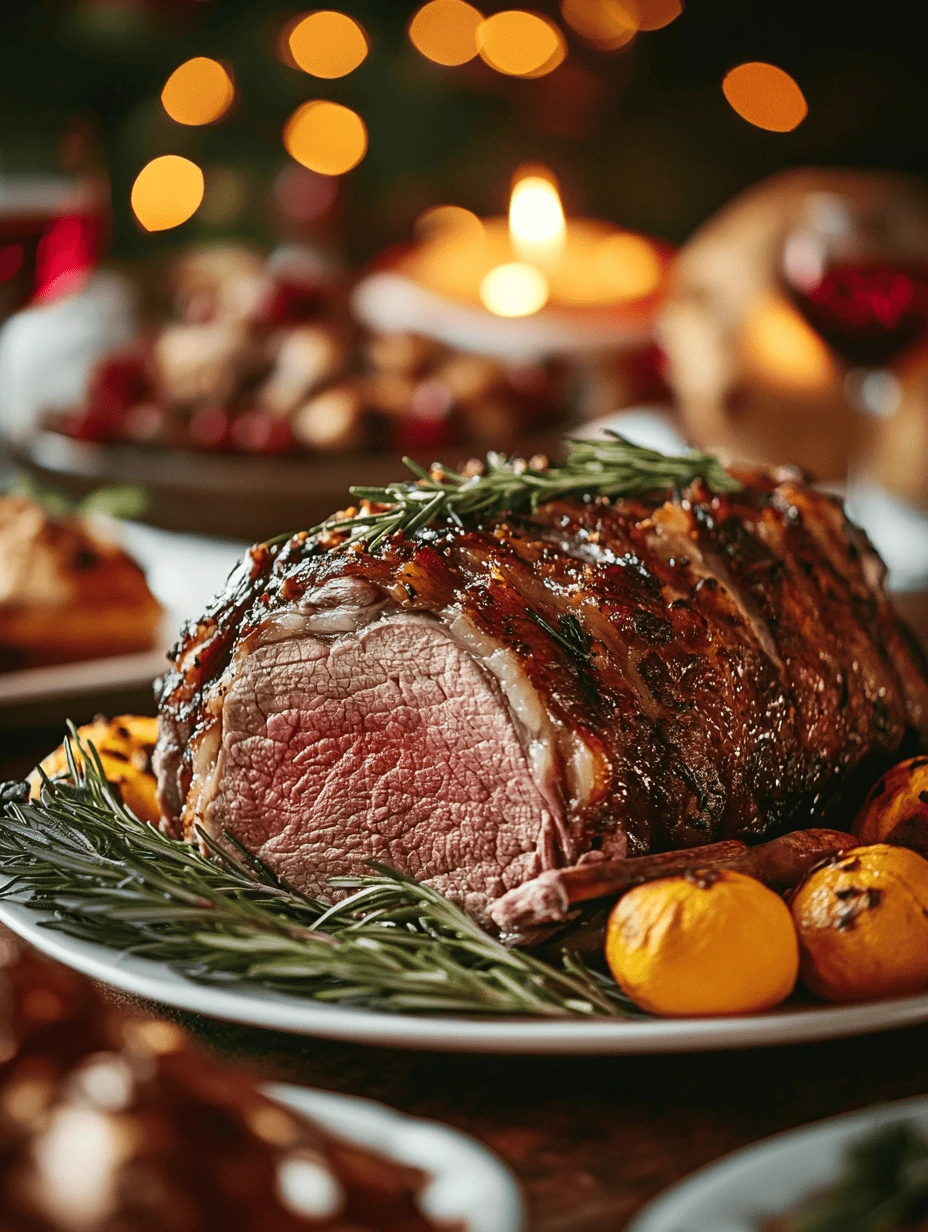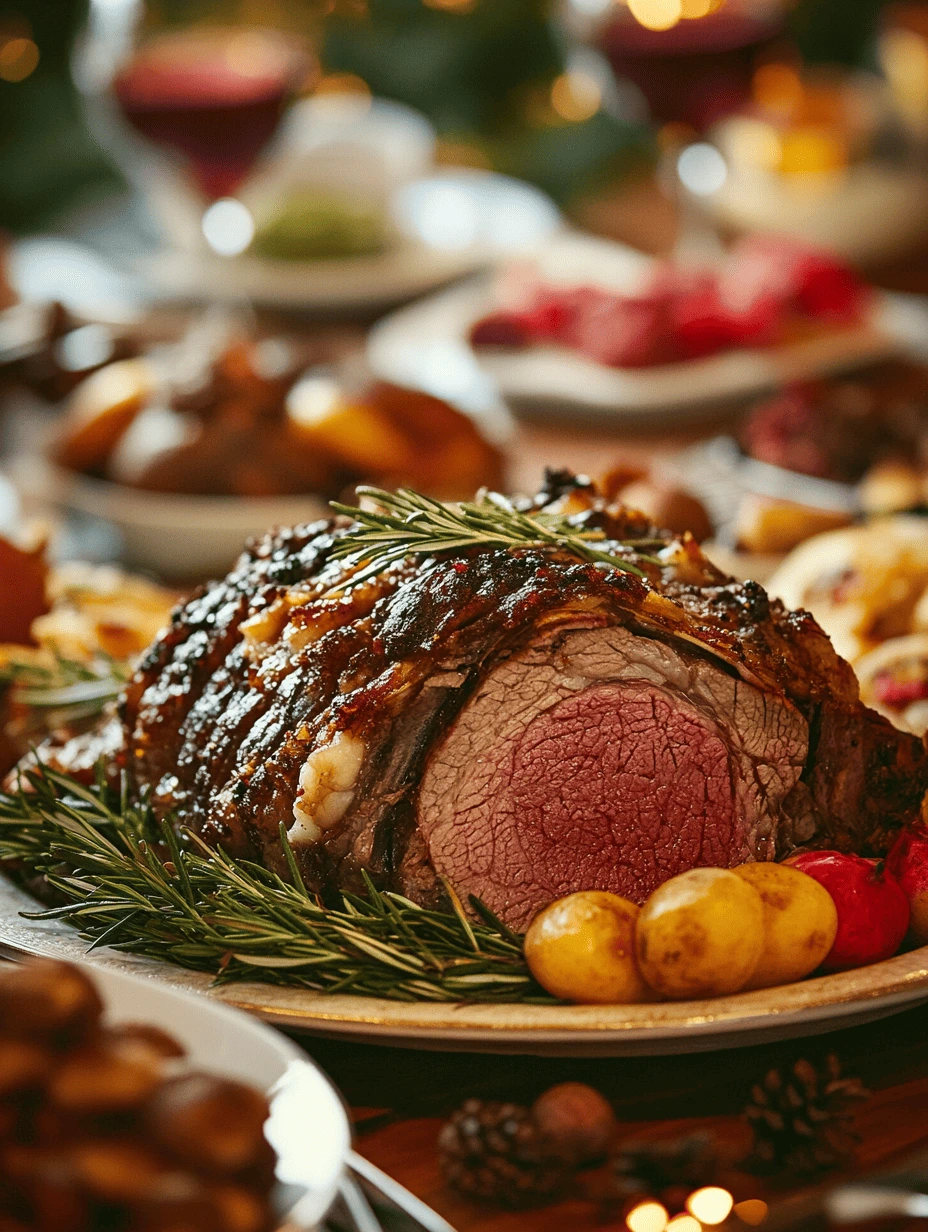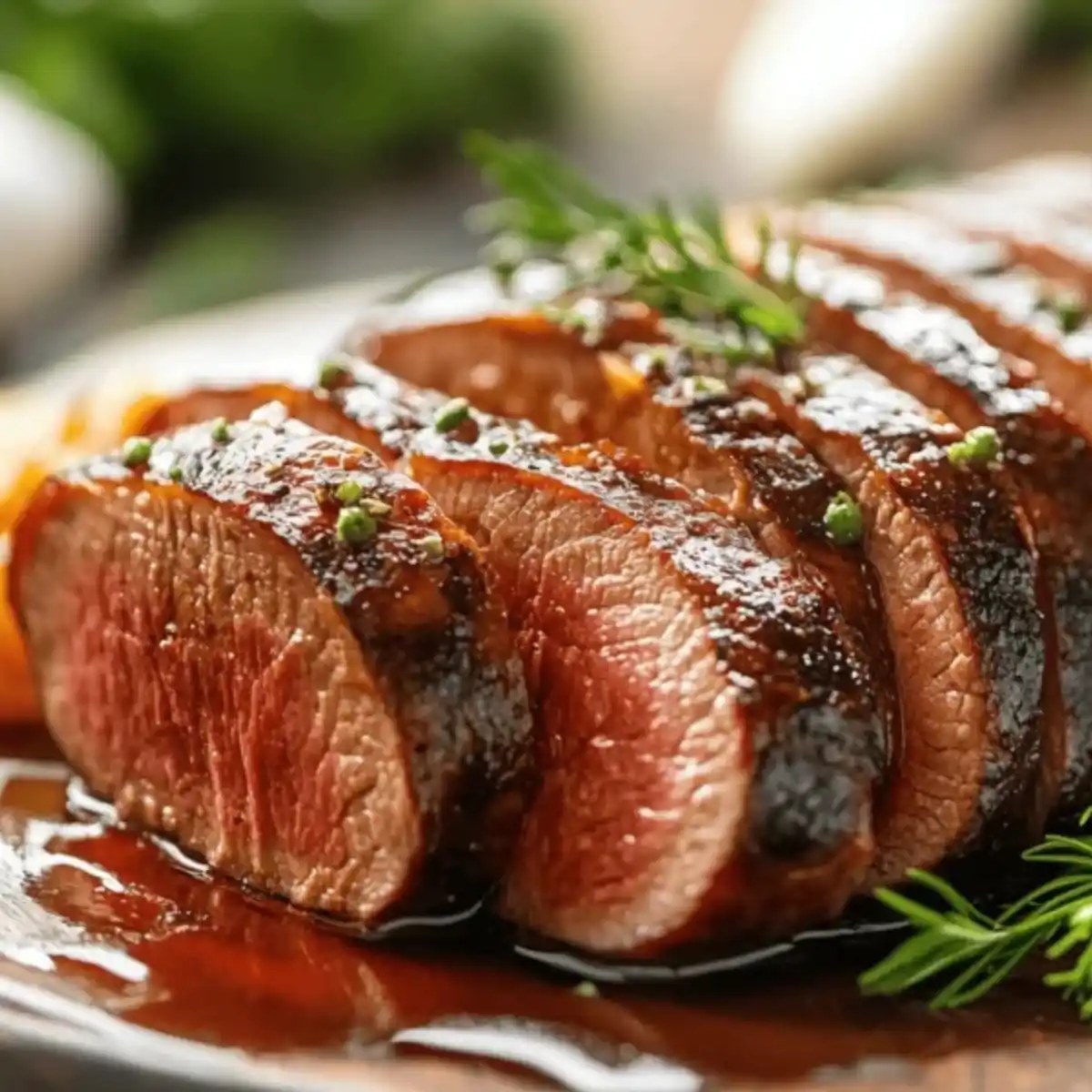The holiday season is coming, and everyone is excited to get together and enjoy a delicious meal. Prime rib is at the center of this tradition, loved by many for its rich flavor. Whether you’re an experienced cook or just starting out, making prime rib can be both thrilling and a bit scary.
But don’t worry, we’re here to help you make the perfect prime rib. We’ll show you how to pick the best cut, season it right, and cook it to perfection. By following our guide, your prime rib will be so juicy and flavorful that your guests will be amazed.

Table of Contents
Key Takeaways
- Discover the key differences between prime rib and regular roast beef
- Learn how to select the best cut for your holiday roast
- Master the art of seasoning and cooking prime rib to perfection
- Explore the benefits of the 500-degree “rule” for achieving the ideal doneness
- Unlock the secrets to creating restaurant-quality au jus and carving your prime rib like a pro
Understanding Prime Rib: What Makes It Special
Prime rib is a standout in beef roast recipes. But what makes it different from other roasts? It’s all about the unique anatomy and marbling of the prime rib.
Difference Between Prime Rib and Regular Roast
Prime rib comes from the upper rib section of the beef. This area is known for its tenderness and rich flavor. Regular roasts, on the other hand, are leaner and can be drier and less flavorful.
The Anatomy of a Perfect Prime Cut
- The prime rib cut is between the 6th and 12th ribs. This area has well-exercised muscle and beautiful marbling.
- The ideal prime rib has a fat cap on top. This fat cap bastes and insulates the meat while it cooks.
- Perfect prime rib has even marbling throughout. This ensures the meat stays juicy and tender when cooked.
This mix of superior marbling, fat coverage, and muscle composition makes prime rib roast special. It’s the top choice for the ultimate beef roast recipe.

“The prime rib is the crowning glory of the beef world, a majestic and magnificent roast that deserves to be the centerpiece of any holiday feast.”
Essential Equipment for the Perfect Prime Rib Recipe
Cooking a prime rib roast at home can seem daunting. But, having the right equipment makes a big difference. Whether you’re following a rib roast cooking instructions or a classic prime rib recipe oven, these tools will help you get great results.
Roasting Pan
A high-quality roasting pan is a must for cooking a prime rib. It should be large enough for your meat and sturdy to prevent warping during cooking.
Meat Thermometer
Getting the perfect doneness is key for prime rib. A reliable meat thermometer is the best way to ensure you reach the right temperature. Choose a digital model with a probe that stays in the meat.
Carving Knife
A sharp, high-quality carving knife is essential for slicing your prime rib. Look for a knife with a long, thin blade that glides through the meat easily.
With these key pieces of equipment, you’ll be ready to make a prime rib fit for any holiday feast. Happy cooking!

Selecting the Best Cut for Your Holiday Roast
Choosing the right cut is key for a perfect prime rib roast recipe. Whether you prefer a bone-in prime rib or a boneless prime rib recipe, knowing the differences is important. It will help you impress your holiday guests.
Bone-in vs. Boneless Options
The choice between bone-in and boneless prime rib depends on your taste and cooking style. Bone-in cuts offer a deeper flavor because of the bones. Boneless cuts are easier to carve and serve, perfect for a simple presentation.
Grade Selection Guide
When picking your prime rib roast recipe, look at the USDA grade. Prime-grade beef is the highest quality, with the best marbling and tenderness. Choice-grade beef is also great, offering excellent flavor and texture. Select-grade beef is cheaper but might not be as juicy or tender.
Size Considerations per Guest
The size of your bone-in prime rib or boneless prime rib recipe depends on how many guests you have. Aim for about 1 pound of raw prime rib per person. This ensures everyone gets enough, with some leftovers too.
By thinking about these factors, you’ll find the perfect prime rib for your holiday meal. With the right preparation and cooking, your roast will be the highlight of the feast.
Prime Rib Temperature Guide for Perfect Doneness
Getting the perfect doneness is key to enjoying a delicious prime rib roast. Whether you like it rare, medium, or well-done, knowing the right prime rib temperature and cooking time is essential.
We’ve put together a detailed temperature guide for prime rib. It covers all levels of doneness:
- Rare: 120-125°F internal temperature. Cooks in about 15-18 minutes per pound.
- Medium-Rare: 130-135°F internal temperature. Takes about 18-22 minutes per pound.
- Medium: 140-145°F internal temperature. Cooks in 22-27 minutes per pound.
- Medium-Well: 150-155°F internal temperature. Takes about 27-32 minutes per pound.
- Well-Done: 160°F and above internal temperature. Cooks in 32-37 minutes per pound.
Keep in mind, these are general guidelines. The actual prime rib cooking time can vary. This depends on the roast size, oven temperature, and desired doneness. Always use a meat thermometer to check the internal temperature.
“The key to a perfect prime rib is to focus on the internal temperature, not the cooking time. Trust your thermometer, not the clock.”
By using this temperature guide and adjusting cooking times, you’ll serve a prime rib that’s perfect every time.
Creating the Ultimate Prime Rib Seasoning Blend
Improving your prime rib roast begins with the right seasoning blend. You might choose a simple salt and pepper mix or a more complex mix of herbs and spices. The perfect seasoning can make your holiday roast unforgettable. Let’s look at the key ingredients and flavor combinations that will highlight your prime rib.
Dry Rub Components
A great prime rib seasoning starts with a basic dry rub. Use coarse salt and freshly ground black pepper as your base. These enhance the beefy taste of the prime rib roast seasoning. Then, add other seasonings to make your unique blend:
- Garlic powder
- Onion powder
- Paprika (smoked or sweet)
- Dried thyme
- Dried rosemary
- Cayenne pepper (for a touch of heat)
Herb and Spice Combinations
For a more complex prime rib rub, mix fresh and dried herbs with bold spices. This can make your rib roast seasoning richer and match the prime rib’s flavor. Some great mixes are:
- Rosemary, garlic, and black pepper
- Thyme, oregano, and smoked paprika
- Sage, fennel seed, and crushed red pepper flakes
Finding the right flavor balance is key for a great prime rib seasoning. Try different mixes and adjust the amounts to match your taste.
“The secret to a truly remarkable prime rib is in the seasoning. Elevate your holiday roast with a custom blend that brings out the best in the meat.”
Step-by-Step Prime Rib Recipe
For the ultimate easy prime rib recipe and best prime rib roast recipe ever, follow these simple steps. You’ll get a mouthwatering, restaurant-quality prime rib every time. This guide will help you create a perfectly cooked, juicy prime rib that will impress your guests.
- Start by patting the prime rib roast dry with paper towels. This helps the seasoning stick and creates a delicious, crispy crust.
- Season the roast with kosher salt, black pepper, and any other herbs or spices you like. Rub the seasoning all over the meat.
- Put the seasoned prime rib on a wire rack over a baking sheet. This allows air to circulate and promotes even cooking.
- Preheat your oven to 500°F. Place the roast in the oven and sear for 15 minutes to lock in the juices.
- After searing, lower the oven temperature to 250°F. Roast the prime rib until it’s cooked to your liking. Use a meat thermometer to check the internal temperature.
- Once the prime rib is cooked, remove it from the oven and let it rest for 15-20 minutes. This step is crucial for a tender, flavorful roast.
By following these steps, you’ll make a best prime rib roast recipe ever that will impress your guests. Enjoy your perfectly cooked, easy prime rib recipe!
Mastering the 500-Degree Rule Method
The “500-degree rule” is a game-changer for roasting prime rib at home. It creates a delicious crust on the outside and keeps the inside juicy and tender. These are the key qualities of a great prime rib roast.
Temperature Timing Chart
The 500-degree rule starts with roasting the prime rib at 500°F (260°C) for 15 minutes. This high heat quickly browns the outside, sealing in juices and flavors. Then, lower the oven to 250°F (121°C) and roast until it’s just right. Here’s a temperature timing chart to help:
| Desired Doneness | Total Cooking Time |
|---|---|
| Rare | 2-2.5 hours |
| Medium-Rare | 2.5-3 hours |
| Medium | 3-3.5 hours |
Rest Period Importance
After the prime rib is cooked to your liking, let it rest for 15-20 minutes before slicing. This rest lets the juices spread evenly, making each slice full of flavor and moisture. By using the 500-degree rule and resting the meat, you’ll get a prime rib that’s truly perfect for your holiday meal.
How to Make Restaurant-Quality Au Jus
Do you love the rich, flavorful prime rib au jus from fancy steakhouses? You can make it at home with a few easy steps. We’ll show you how to make prime rib au jus just like the restaurants do.
The secret to great prime rib au jus is the pan drippings. These juices are full of flavor. By simmering them with some extra ingredients, you get a rich, savory sauce that goes perfectly with your prime rib.
- Collect the pan drippings from your perfectly cooked prime rib. These drippings are packed with beefy goodness.
- Add some beef broth or stock to the pan, scraping up any browned bits from the bottom. This will help create a more robust flavor.
- Simmer the mixture over medium heat, allowing it to reduce and thicken slightly. This concentrates the flavors.
- For added depth, you can stir in a splash of Worcestershire sauce, a pinch of dried thyme, or a bit of garlic powder.
- Taste and adjust the seasoning as needed, adding salt and pepper to your liking.
By following these simple steps, you’ll have a restaurant-worthy prime rib au jus that will elevate your prime rib to new heights. The secret to restaurants’ tender prime rib lies in their careful cooking techniques, such as the 500-degree method, which you can learn more about in the previous section. Pair your prime rib with this flavorful au jus, and you’ll have a truly unforgettable holiday feast.
Professional Carving Techniques
Mastering the art of carving a prime rib roast is key to a stunning holiday meal. With the right tools and techniques, you can turn your perfectly cooked prime rib into elegant slices. These prime rib carving tips will help you carve like a pro, whether you’re a seasoned chef or a first-time host.
Required Tools
To carve your prime rib like a pro, you’ll need a few essential tools:
- A sharp, long carving knife
- A carving fork to hold the roast steady
- A cutting board large enough to accommodate the entire roast
Step-by-Step Cutting Guide
Follow these steps to carve your prime rib with precision:
- Allow the roast to rest for at least 15-20 minutes after cooking, allowing the juices to redistribute.
- Position the roast on your cutting board with the bone side facing you.
- Holding the carving fork firmly, slice the meat across the grain in thin, even slices, starting at the narrow end of the roast.
- Use your carving knife to gently separate each slice from the bone, ensuring a clean, uniform cut.
- Arrange the slices on a serving platter, ensuring they maintain their shape and presentation.
Remember, the key to which is the best way to cook prime rib? is to let the roast rest before carving. This allows the juices to settle, resulting in tender, flavorful slices that will have your guests raving.
“Carving a prime rib roast is an art form. With the right techniques, you can transform your holiday centerpiece into a visually stunning and delicious masterpiece.”
Delicious Side Dishes to Complement Your Roast
When you’re cooking a prime rib or holiday roast beef, it’s key to have tasty side dishes. These can range from classic choices to something new. They’ll make your meal complete and memorable.
Begin with roasted potatoes, a classic with prime rib. Just toss small potato cubes with olive oil, garlic, and herbs. Roast them until they’re crispy and golden. For a creamy side, mashed potatoes are a hit. Add heavy cream, butter, and chives for extra flavor.
To balance the rich prime rib, serve fresh roasted vegetables. Mix Brussels sprouts, carrots, and parsnips for a colorful dish. Or, go for steamed asparagus or green beans. A drizzle of balsamic glaze adds sweetness.
- Roasted potatoes
- Mashed potatoes
- Roasted vegetables (Brussels sprouts, carrots, parsnips)
- Steamed asparagus or green beans
For something different, try a wild rice pilaf or a quinoa salad with cranberries and pecans. These grains offer a nice contrast to the roast.
No prime rib meal is complete without creamy horseradish sauce or classic au jus for dipping. These add a burst of flavor that complements the roast perfectly.
With these tasty side dishes, your holiday feast will be unforgettable. Pair your prime rib or holiday roast beef with these options for a memorable meal.
Storing and Reheating Leftover Prime Rib
After enjoying your prime rib roast, you might have leftovers. It’s important to store and reheat them right to keep the meat tender and flavorful. These tips work for both small how to cook a small prime rib roast and larger prime rib recipe bone-in cuts.
Storage Best Practices
To keep your leftover prime rib fresh, follow these steps:
- Let the roast cool completely before storing.
- Wrap the prime rib tightly in aluminum foil or plastic wrap, ensuring no air pockets.
- Place the wrapped roast in an airtight container or resealable bag.
- Store the leftovers in the refrigerator for up to 3-4 days or in the freezer for 2-3 months.
Reheating Methods
Ready to enjoy your leftovers? Here are some good ways to reheat them:
- Oven Reheating: Preheat your oven to 250°F (120°C). Place the prime rib on a baking sheet, cover loosely with foil, and heat for 10-15 minutes, or until the desired temperature is reached.
- Stovetop Reheating: Slice the prime rib and reheat it gently in a skillet with a small amount of beef broth or au jus. Cover and warm over low heat, flipping the slices occasionally, until heated through.
- Microwave Reheating: While not the preferred method, you can reheat small portions of prime rib in the microwave. Place the slices on a microwave-safe plate, cover with a damp paper towel, and heat in 30-second intervals until warm.
Choose your reheating method wisely. Avoid overcooking, as it can make the prime rib dry and tough. Heat it gently and slowly to keep it tender and flavorful.
By storing and reheating your prime rib leftovers correctly, you can enjoy them again. They’ll taste just as good as the first time.
Conclusion
Creating the perfect traditional prime rib recipe is an art. It needs careful attention to every detail. From picking the best meat to mastering the 500-degree cooking method, each step is key.
Now, you know how to make your holiday meals unforgettable. With the right knowledge and skills, your gatherings will be culinary wonders. Your prime rib will be the highlight of any event, big or small.
Success comes from being precise and paying attention to details. Follow the tips and recipes here to make a prime rib that’s tender, juicy, and full of flavor. Your guests will be amazed by your cooking skills.
Explore Related Recipes and Tips
To complement your prime rib and enhance your holiday table, consider exploring these related recipes and cooking guides:
- Learn How to Make Perfect Roast Beef at Home
Understand the techniques and secrets to creating a succulent roast beef that rivals the best prime rib. - Delicious Beef Cheek Meat: Tender, Flavorful Cuts
A unique recipe to explore rich and flavorful beef dishes that can pair perfectly with your holiday spread. - 5 Reasons Why Beef Cheeks Are Perfect for Slow-Cooked Meals
Dive into the world of beef cuts with this guide that uncovers the secrets behind beef bacon. - Easy Homemade Chicken Bone Broth Recipe for Beginners
Make a flavorful broth that serves as an excellent base for au jus to accompany your prime rib.
FAQ
What makes prime rib so special?
Prime rib is loved for its marbling, tenderness, and rich flavor. It comes from the rib section, known for being tender. This makes it a juicy, flavorful dish, considered a true delicacy.
What’s the difference between prime rib and regular roast beef?
Prime rib comes from the “prime” section, which is the most tender and well-marbled part. Regular roast beef is from less expensive cuts, lacking the same marbling and tenderness.
What is the 500-degree rule for cooking prime rib?
The 500-degree rule involves searing the roast at 500°F for 15 minutes. Then, lower the heat to finish cooking. This method creates a flavorful crust and a perfectly cooked interior.
How do restaurants make prime rib so tender?
Restaurants use high-quality, well-marbled cuts and a flavorful rub. They also control the temperature precisely during cooking. Proper resting and carving are key to maintaining tenderness.
What’s the best way to cook prime rib?
The best method is searing at high temperature, then roasting at a lower temperature. Monitor the internal temperature and let it rest before carving. This ensures a perfect prime rib.
How do I choose the right size prime rib roast?
Choose a size based on the number of guests. Plan for about 1 pound per person. Bone-in roasts are slightly heavier than boneless ones.
What’s the best seasoning for prime rib?
A simple salt and pepper blend is classic. But you can also use herbs, garlic, and spices for a more complex flavor. The goal is to enhance the beefy taste of the prime rib.
How do I make a restaurant-quality au jus for prime rib?
Start with the pan drippings from the roast. Deglaze with beef broth and simmer to concentrate the flavors. Add herbs, garlic, and a splash of red wine for depth. Let it reduce to a rich, velvety consistency.
How do I properly store and reheat leftover prime rib?
Wrap the roast tightly in foil or plastic wrap and refrigerate. It keeps for 3-4 days. Reheat by slicing and warming in a skillet or oven, or by reheating the whole roast at 250°F. Avoid overcooking to keep it juicy.


2 thoughts on “Best Prime Rib Recipe: Perfect Holiday Roast”